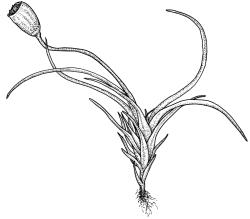- ≡ Aongstroemia sect. Campylopodium Müll.Hal., Syn. Musc. Frond. 1, 429 (1848)
Plants small, on mineral soil. Stems short or rarely elongate, branching by innovation or forking, often with multiple perichaetia, in cross-section with central strand weak or lacking, sparsely beset with smooth brown rhizoids below. Leaves often sheathing at base and distinctly shouldered, with a long subula nearly filled by the costa, little altered when dry, the lower vegetative leaves grading quickly into the perichaetial leaves in fruiting plants, entire or serrulate above, unistratose or with bistratose margins. Laminal cells of leaf base (in leaves from below perichaetium) narrowly rectangular, firm-walled, c. 30–60 µm in N.Z. species. Upper laminal cells (in leaves from below perichaetium) short-rectangular or oblong, incrassate, and smooth; alar cells not differentiated. Costa (in leaves from below perichaetium) occupying c. ⅙–¼ the leaf base, percurrent or short-excurrent, usually not filling the subula, in cross-section (mid leaf) projecting and rounded on abaxial surface, with median guide cells, and both adaxial and abaxial stereid groups.
Dioicous or paroicous. Perichaetia often >1 per stem. Setae stout or rather slender, cygneous when moist, flexuose and strongly dextrorse when dry; capsules emergent (not or scarcely exceeding ♀ leaves), broadly ovoid or weakly obovoid, mostly weakly asymmetric at base, weakly sulcate when moist, strongly 8-ribbed and constricted below mouth when dry; exothecial cells in alternating thin- and firm-walled bands (not well illustrated here); stomata superficial, restricted to capsule base; annulus of 1–2 rows of vesicular cells, not revoluble, falling with the operculum; operculum curved-rostrate from a conic base. Peristome teeth red-brown, inserted at mouth, split c. half-way to base, papillose-striolate below. Calyptra cucullate, not fringed at base. Spores coarsely baculate-insulate.
A genus of two species recorded by Giese & Frahm (1986a) from N.Z., Tasmania, Malesia, Polynesia including Hawai‘i, The Philippines, Taiwan, Japan, New Caledonia, Chile, and Puerto Rico. Both species occur in N.Z. The lack of records from mainland Australia seems peculiar and is perhaps a collection artefact.
The treatment of Campylopodium as a genus of two species by Giese & Frahm (1986a) is followed here, with the exception of one name change (C. capillaceum replacing C. medium for reasons discussed below). Wijk et al. (1959) treated 11 species in the genus, but most of these were placed in the genus Microcampylopus, many as synonyms, by Giese & Frahm (1986b). Giese and Frahm (1986b) recognised Campylopodium and Microcampylopus as distinct genera; no species which they assigned to Microcampylopus occurs in N.Z. Campylopodium is the earlier of the two names. However delimited, Campylopodium is closely allied to Dicranella.
Campylopodium shares more features with Dicranella than with Campylopus. Indeed, Giese & Frahm (1986a, p. 126) noted that it is "distinguished from Dicranella only by the curved setae. The leaf morphology and anatomy is exactly that of Dicranella." Features suggestive of Dicranella include the nature of the laminal cells, the absence of differentiated alar cells, costal morphology, capsule form (being similar to those species of Dicranella with symmetric capsules), the nature of the peristome teeth, and the presence of stomata in the capsule base. The boundary between Campylopodium and the northern hemisphere genus Cynodontium is unclear but not discussed here.
When fruiting, the strongly cygneous setae coupled with short stems, relatively narrow costae, and subulate, often sheathing leaves make this genus recognisable regionally. When sterile the plants are strongly suggestive of a Dicranella.
| 1 | Paroicous; leaves not sheathing, with an ovate base gradually contracted to a ± linear subula; margins bistratose; capsules broadly ovoid | C. lineare |
| 1' | Dioicous; leaves sheathing, with an oblong base suddenly contracted to a long subula; margins unistratose; capsules ovoid to short-cylindric | C. capillaceum |
| Category | Number |
|---|---|
| Indigenous (Non-endemic) | 2 |
| Total | 2 |
Campylopodium buchananii (Stirt.) Paris [Index Bryol. Suppl. 88, 1900]. Isotype material in CHR (J. Buchanan 65 from Wellington, CHR 543123A!) is C. capillaceum. This material was correctly named by Brotherus as Campylopus flexipes, an earlier heterotypic synonym. However, Dixon (1914, p. 71) and Giese & Frahm (1986a) both included Campylopodium buchananii and its homotypic synonyms in the synonymy of Campylopodium lineare. It is likely that the Buchanan collection is mixed and that a lectotype needs to be selected in order to clarify the application of this name.




